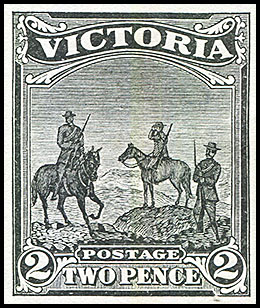The Essays.
As with the 1897 Hospital Fund issue, a public competition was held supported by the wave of strong patriotic feeling for the cause - if not for the concept of the issue. The plan was to have two denominations and suggestions could be entered for one denomination or for both.
The first prize for each denomination was 5 guineas (£5/5/-) while the second prize for each denomination was 2 guineas (£2/2/-).
The attention of the community of (hopeful) stamp designers was attracted and 120 entries were received. All entries were submitted under a nom-de-plume. The sole judge was Mr. W. A. Watt, the Postmaster-General of Victoria.
 |
The sole surviving essay of the 1900 competition.
Titled "Victoria Cross" and submitted by Sands & MacDougall. Annotations by W.A.W. (Postmaster-General Watt). Prestige Philately, April 2006, Lot 421. The auction catalogue states the following:
|
|
|
It is amazing that such a distinguished award for Military Honours is depicted on only the stamp printed from this Essay.
The Essay is therefore sought after by a variety of collectors representing a wide range of philatelic collecting interests.
The Proofs.
Proofs were taken from the steel dies engraved by Samuel Reading for both denominations. Only seven were printed - all on wove paper:
- for the 1d: in purple-brown (ex Purves) and in claret;
- for the 2d: in black, in orange (two), in brown-red and in green on pale green paper.
 2d (2/-) die proof in black and printed on thin wove paper. Only known example in this colour. Has a wider border - about 4 mm left, Provenance: Besacon (Corinphila Nov. 2018, |
Wide border: Rod Perry Auction, September 1993 (?); |
Prestige Philately January 2004 Lot 615. |
Provenance: Purves. Rodney Perry April 1994 Lot 1258. |


